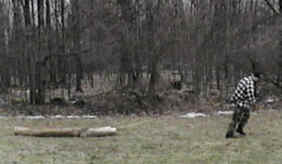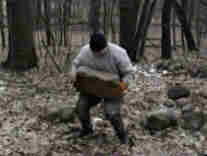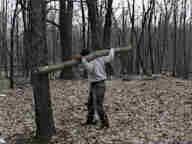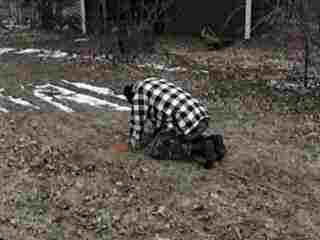|
Rookie Dinosauria
 Dinosaur training. It is
a phrase we have all heard and maybe even tried at some point. Brooks
Kubik made the training methodology famous with his book of the same title.
Since I heard of the book I have been intrigued by the whole thought of
Dinosaur training. Lifting weights in the gym is great for
building strength but, the applicability of Powerlifting motions are limited,
to an extent, in the uses outside of Powerlifting. So what I wanted
to accomplish was to tie together all the strength I gain in the gym to
the application of just about anything my heart desires. We all know
that trying to lift a 135# bar overhead is different than trying to lift
a 135# rock overhead. If you don't think so, give it a try.
Dinosaur training. It is
a phrase we have all heard and maybe even tried at some point. Brooks
Kubik made the training methodology famous with his book of the same title.
Since I heard of the book I have been intrigued by the whole thought of
Dinosaur training. Lifting weights in the gym is great for
building strength but, the applicability of Powerlifting motions are limited,
to an extent, in the uses outside of Powerlifting. So what I wanted
to accomplish was to tie together all the strength I gain in the gym to
the application of just about anything my heart desires. We all know
that trying to lift a 135# bar overhead is different than trying to lift
a 135# rock overhead. If you don't think so, give it a try.
My journey into the primordial
ooze of powerlifting is in the initial stages. I have only been utilizing
this stuff for about 3 months. The motions I am doing and terming
“Dinosaur Training” may differ from Brooks Kubiks book so, we can make
this the rookies’ version and call it “Caveman Training.” What better
to call throwing rocks and hoisting trees? I am slowly adding more
motions to the list of things I do. It takes a little time to adjust
to the increased volume of work each week (I do these on Saturdays).
Since the majority of the things I do are compound movements I am trying
to keep it simple for the time being. These are extra work and sort
of fun so I don't regiment the program...for now. I do go balls out
on the intensity though. I have fun tossing rocks and lifting trees
but, I am trying to do this for the purpose of getting brutally strong.
It will definitely get you in touch with your “Caveman” ancestry.
I come back from these workouts covered in dirt, sweaty, and grinning from
ear to ear. My wife thinks I have absolutely lost my mind.
My initial days
of Dinosaur stuff were basically restricted to dragging. I utilize
a “Louie” program and it is plenty of work so I wanted to start off easy.
I didn't have any weights to hook up (traditional drag is with 45# or 100#
plates) so I decided to improvise and use some trees. I made a “little”
log and a “big” log to drag depending on what was slated for my next conventional
lifting day. If I had a Squat or Heavy legs day coming up then I
would take the “little” log out.  If it were a chest day of sorts then the “big” boy got the nod. Now
when I started dragging these logs it was early January and there was snow
on the ground. This made the dragging part easier but, the breathing
part was a challenge. Gasping cold air is not a recommended activity.
In addition to dragging I would toss around a chunk of wood. Generally
I would do about 2 sets of 5 reps throwing the wood chunk vertically,
a push-press type of bench motion, and a twisting over-the- shoulder throw
for each side. The dragging really works the hip/glute area as well
as killing your legs and calves.
If it were a chest day of sorts then the “big” boy got the nod. Now
when I started dragging these logs it was early January and there was snow
on the ground. This made the dragging part easier but, the breathing
part was a challenge. Gasping cold air is not a recommended activity.
In addition to dragging I would toss around a chunk of wood. Generally
I would do about 2 sets of 5 reps throwing the wood chunk vertically,
a push-press type of bench motion, and a twisting over-the- shoulder throw
for each side. The dragging really works the hip/glute area as well
as killing your legs and calves.
My dragging trail
is about 1/4 mile long for the full length and at the half-way mark it
starts to incline. This continues 'til about the 2/3 mark and then
does a little downhill run to the end. It is nice because the beginning
is somewhat easier and provides a ‘warm-up’ time then the hill really works
the muscles. The little log is taken the full 1/4 mile while the
big log gets taken to the top of the hill before the return trip.
The variation of the terrain makes for nice changes in the intensity.
I kind of get a peak-rest type of workout. The strap
I use to drag the logs is nothing fancy. I tie a rope through a hole
in the front of the log and then attach a motorcycle tie-down strap to
a loop at the other end of the rope. The tie-down is about 2-3" wide
so it distributes the load pretty good. I'm sure there are an infinite
number of variations so use whatever you can.
Once February came
around the temperature started to rise somewhat. In Michigan we were
actually experiencing 50+ degree days. This was not normal and to
boot it took my friction eraser away (snow: in layman's terms)! Dragging
these logs without the benefit of the snow was a WHOLE different story.
I came away from the drag sessions gasping and had nothing left for any
type of throwing. Give me a break eh? It is amazing enough
for me to walk a 1/2 mile...let alone drag a tree! So the dragging
was the norm until the end of February. In the waning days of February
I spent a day looking for some good rocks and trees. My family has
a chunk of land and luckily they have a big rock pile and some very large
rocks.  Too big for this stage of the game anyway. At the end of the rock
hunting session I had three good size stones for lifting/carrying and three
good throwing/pressing stones. I tried to vary the shapes and weights
so I would not adapt to moving them too quickly. With the different
shapes you can pick a multitude of ways to grasp and lift the stones.
Believe me, they all hit a little different areas depending on where you
grip it.
Too big for this stage of the game anyway. At the end of the rock
hunting session I had three good size stones for lifting/carrying and three
good throwing/pressing stones. I tried to vary the shapes and weights
so I would not adapt to moving them too quickly. With the different
shapes you can pick a multitude of ways to grasp and lift the stones.
Believe me, they all hit a little different areas depending on where you
grip it.
After the rock hunt it
was time to find some trees. I have the two I use for dragging and
the little one is good for lifting but, the big one is just a little too
cumbersome for me right now. I want to try some Highland games this
year so I figured a Caber would be a good addition to my un-conventional
training. Let me just interject some thoughts here. Turning
the Caber is NOT, I repeat NOT, an easy thing to do. My first attempt
at one was 19' and not really all that straight. I couldn't weigh
it at the time so I am unsure how heavy it was. Straight is good
for Cabers and bent is bad in case you didn't know. Just trying to
balance it was a chore. As a result this tree got cut down to about
12' and is now a practice Caber to actually learn *how* to do it.
I also made an 18' foot tree that I want to utilize but, it is Ironwood
and I think it is too heavy. The collection of these materials coupled
with some playing was sufficient for a days work. I had a good chunk
of paraphernalia to work with and didn't see the need to overextend on
what I was doing. This marked a little more structure to my
Dinosaur training from this point on. I had gained a good amount
of endurance and my strength was improving nicely from the conventional
training. I figured it was time to start pushing a little bit more
on the Dinosaur day!
With the addition
of my new “toys” this training really has taken a turn for the better.
I start off the sessions with a drag (big or little depending, see above)
and follow it with some rock play. I escalate from smallish rocks
to bigger ones and do about 5 overhead presses until it is too heavy to
clean. The final rep (number 6) is generally a push-press bench type
throw with the rock. This is great for explosion and I can feel the
effects when I bench. Once the pressing/lifting is done I move to
my three big rocks. These are about the size of my torso and I don't
know how much they weigh but, I find them very heavy and it is work to
get them up to chest height. The whole motion reminds me of watching
WSM and the McGlashen stones. I pick the rock off the ground and
squat WAY down to get it up on the legs. I can get a more solid grip
from this point then it is just a Zercher type squat. The rock is
much more cumbersome and puts a lot of strain on the lower back.
I think the training with somewhat rounded back (you can't keep it straight
with the rock in hand) has helped my lumbar strength tremendously.
I try to make a lift with each of the three big rocks. They are similar
in weight but, shaped differently and it adds a little variation.
The last rock usually gets a walk too, roughly 20 yards down and back.
This will really test your back so I suggest being VERY careful with the
rocks and the walking especially.
Movements for Dinosauria
|
1. Small log dragging:
Take log on 1/4 mile run. Down and back, emphasis
on consistent tempo and endurance.
2. Large log dragging:
Take log uphill roughly 50-100 yards. 4-5 runs
uphill and return. Emphasis on powerful strokes
in consistent tempo.
3. Stone lift:
Single lift repetitions. Lift from ground or
off platform. Lift to standing position. Variation is to walk
distance with stone at chest height.
4. Stone clean:
Single repetition. Lift from ground and clean
to chest. If possible press overhead.
5. Stone throw(s): Two
handed throw overhead, two handed throw over shoulder (each side), and
one and two handed throws horizontal off chest.
6. Log lift:
Zercher style lift with logs of varying size.
Single lift repetition. Variation is to walk distance with log held
chest height.
7. Caber toss:
Self-explanatory. Take 5-10 throws after completion
of lifting motions.
8. Log side bends/twists:
Shoulder log like squat. Bend side to side
touching tip of log to ground. Try for 5-8
touches per side or like number of twists.
9. Bag throw:
Simulation of weight toss and hammer throws.
Varying weights. 5-10 throws each.
10. Lumberjack:
Sledge hammer pounding on stationary object.
Either overhead strikes or side strikes. Take either 25 strokes on
each side and each direction or, 50 strokes each side.
11. Sledgehammer raises:
Grasping Sledge by handle at distance from head you
can perform 5-10 raises. Increase distance as strength increases.
12. Plier curls:
Using pliers to grip handle of pale, perform 5-10
curls per arm.
13. Grip front raises:
Holding rock in “pinch grip”, perform 5-10 front
raises with palm down orientation. |
|
With the big rocks satisfied
I move over to my smaller throwing rocks. I give these about five
throws each. These are the same throws I used to use the chunk of
wood for but, the rocks are more compact and offer better handholds.
I won't stop using the wood chunk but, for now I am varying it with the
rocks. I am guessing these rocks are about 30-50# (?) and seem to
offer sufficient resistance for a good workout. I am going to add
some sandbag type contraptions to simulate the 28# and 56# weights used
in Highland games. I am still working on a cheap imitation of the
22# hammer. I really like the throwing type motions because they
are tremendous work for explosion. Louie Simmons and Fred Hatfield
(the two gurus I have had the most success following) both have spoken
of the importance of being explosive. I am noticing increases in
my ability to “start” the big three. The use of the odd shaped
weights coupled with the explosive nature of the motion really brings a
great many muscles into play. I have to be careful because the major
movers ( legs, hips, etc.) are so strong they overburden the smaller stabilizers.
I am strong in a straight pull with my back but, twisting type motions
haven't been worked in a while so I err on the side of caution here.
Okay, this brings me
to my final segment of training. I like to keep working on the abdominal
region so I have devised what I call “Tree Benders.” This utilizes
my very small caber and is hell on wheels for your obliques and surrounding
stabilizers (these puppies hurt the day after the day after!). Really
all they are is side bends with the weight on your shoulders instead of
in your hands. The length of the tree is so unbalancing and cumbersome
it requires a lot of stabilizers to perform. I generally keep this
in the 5-7 rep range per side and follow it with some twists. To
do the twists I highly suggest you use a tree in front of you to stop the
momentum of the tree on your shoulders.  You can do them much harder and the only dangerous aspect of the twists
(I have come across to date, anyway) is trying to stop the twist motion.
Very stressful on the pec/delt tie-in and hard on the lower back too.
With a tree to stop the motion you can bang it as hard as you want and
even get some explosion out of it (just don't drop the tree cuz’ you hit
your stopper too hard ;-p). Once I finish the “ab” stuff I am moving
into an experimental “aerobic” type phase. I know, I know...the nasty
“a” word but, I look at Lumberjacks and they all seem to have big barrel
chests (besides, “Kaz” used to lumberjack). My version of “aerobic”
is simply to use a sledgehammer and beat on a stump or tree. I use
the stump for overhead strikes and a tree for sideways strikes. You
get a rhythm going and you are breathing heavy after a few minutes.
This is still experimental and I haven't had a chance to really see if
it is going to help but, it is fun nonetheless (“bad tree...bad tree!”).
At this point I am pretty much whipped. The conventional stuff during
the week has sapped a lot of energy and then this stuff on my day off...(*angry
pause*) takes the last motivation I have. I do try to do a little
grip work before I leave. Generally playing with the sledgehammer
is good. I do some tilting and standing it up with forearm strength.
I have to short grip the handle cuz’ I am not that strong...yet.
You can do them much harder and the only dangerous aspect of the twists
(I have come across to date, anyway) is trying to stop the twist motion.
Very stressful on the pec/delt tie-in and hard on the lower back too.
With a tree to stop the motion you can bang it as hard as you want and
even get some explosion out of it (just don't drop the tree cuz’ you hit
your stopper too hard ;-p). Once I finish the “ab” stuff I am moving
into an experimental “aerobic” type phase. I know, I know...the nasty
“a” word but, I look at Lumberjacks and they all seem to have big barrel
chests (besides, “Kaz” used to lumberjack). My version of “aerobic”
is simply to use a sledgehammer and beat on a stump or tree. I use
the stump for overhead strikes and a tree for sideways strikes. You
get a rhythm going and you are breathing heavy after a few minutes.
This is still experimental and I haven't had a chance to really see if
it is going to help but, it is fun nonetheless (“bad tree...bad tree!”).
At this point I am pretty much whipped. The conventional stuff during
the week has sapped a lot of energy and then this stuff on my day off...(*angry
pause*) takes the last motivation I have. I do try to do a little
grip work before I leave. Generally playing with the sledgehammer
is good. I do some tilting and standing it up with forearm strength.
I have to short grip the handle cuz’ I am not that strong...yet.
Well, there you
have it. It is pretty simple and I am happy with the results so far.
Especially since I started doing this stuff before my lower back was 100%
healed. It has helped to re-strengthen it and I think it is past
where it was. I am being a little on the cautious side for two main
reasons. (1) The fact I was coming off a back injury and had spent the
last year getting it straightened out. (2) I have a meet on April
4th and I don’t want to overdo it before the meet. The meet is a
push/pull so it is test time for the back to see how well it has rehabilitated.
I am confident it is going to hold up fine and even give me more than I
am expecting. I seriously attribute a great deal of this to the fact
I have been using un-conventional training. I give Louie Simmons
credit as his system has been EXTREMELY beneficial to me as well.
I think the rocks and trees have solidified all that training and connected
everything. I am going to keep pushing this stuff and will see how
much it can help in the future. Again, is it the regular program
or is it the unconventional “Caveman” type stuff? I think it is both...I
could be crazy but, I like it, and I think it is beneficial to my training.
I will keep everyone
updated on the progress and any new variations I come across. I hope
this has sparked some ideas or maybe motivated someone to go give it a
try. It is fun and is great for tying all the stabilizers and so
forth together. It is humbling at first because rocks and logs are
MUCH harder to lift than weights and bars. I was disappointed at
the meager size of some of my implements at first. Now, I am manhandling
most of them and I have upgraded many as well. It is just like any
other lifting...start at the bottom and work your way up. It is much
nicer to toss a rock off your chest than setting it nicely down like you
would with a bar (unless you are lucky and get to use rubber weights).
If you have some time
one of these days and you got a few rocks and trees...head out and play
with them for a bit. Grow some hair on your knuckles and reduce your
vocabulary to grunts and high- pitched wails (when you drop a rock on your
foot). If you get really good you can advance to the status of everyone's
favorite Caveman...Grog!! Hair, lips, and legs!
What more could you ask
for? Try yelling “GROG” at the top of your lungs on heavy
deadlifts and see how much attention you get. I doubt you will get
asked for training tips very often but, once people see the iron you toss...they
may overcome their fear of hair and your odor of “au natural” long enough
to learn something new and useful. So in the meantime, keep cooking
your food and help to keep Bic in business. Maybe you'll hear one
of my ‘Grog’ calls and we can talk about lifting over some real “Grog.”
Stay strong, lift smart, and best of luck.

| Wade
Hanna is a former High-School and Collegiate football player (Middle Linebacker
and Nose guard) who was involved in Track & Field throwing events as
well (Shot, Discus, Javelin). After College he enlisted in the United
States Marine Corps where he worked in Corrections. A weightlifter
since the age of 14 Wade is a recent addition to competitive Powerlifting.
Bitten by the competitive bug he competes in the #275 weight class with
hopes of advancing to the #319. Married and the father of one daughter
Wade currently works for the Michigan Senate. |
|
|
Want to discuss this with other lifters?
|
Then click here:
 |
|
Reproduction of this article,
in whole or part, for any purposed other than personal use is prohibited
without written consent. Copyright 1998 Wade Hanna. |
|